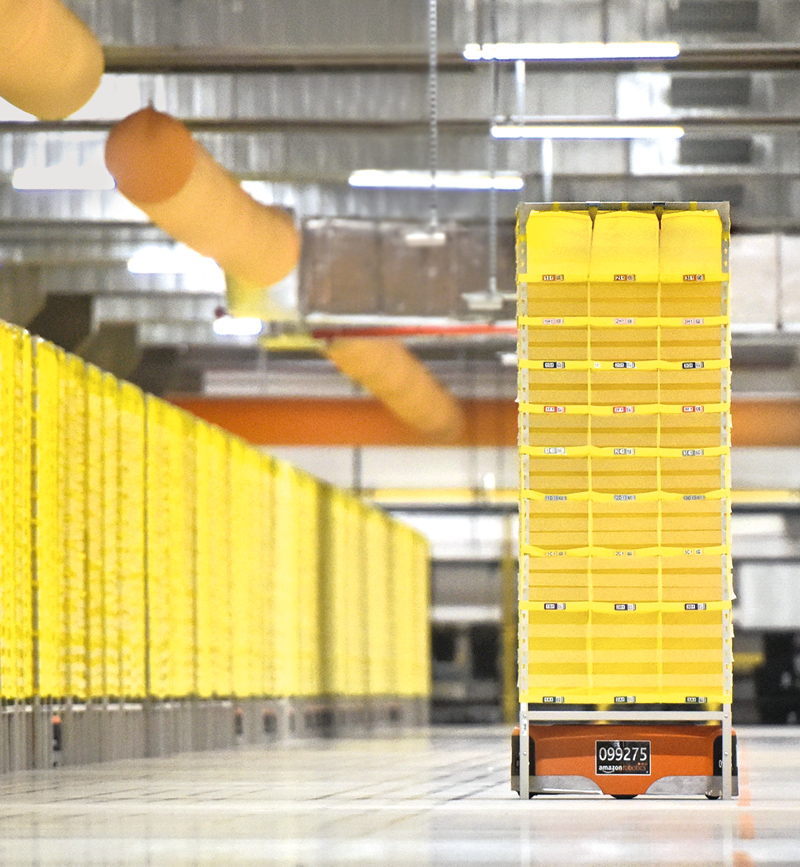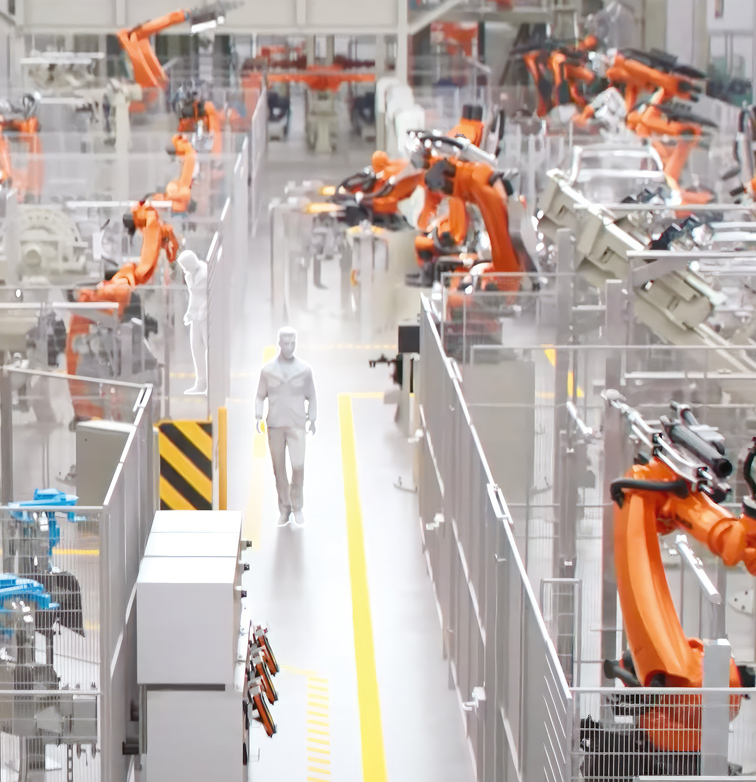Artificial Intelligence – between hype and everyday business
Artificial intelligence (AI) is currently an omnipresent topic, thanks to the new opportunities opened up by generative AI. Hardly a day goes by without reports on the latest sensational projects and findings. Yet in many industrial and commercial companies AI has long found its way into day-to-day business routine and become an established tool there. Where is it already used, what aspects should implementers consider and what opportunities does AI have to offer?
Entire texts at the touch of a button and deceptively real images automatically generated: both the chatbot ChatGPT and the image generator DALL-E have made artificial intelligence a global talking point. Yet AI is already used in many business functions and is the norm when it comes to digitalising production and production processes as well as in research and development.
According to a study by McKinsey, the management consultants, AI adoption has more than doubled since 2017. More than 50 per cent of respondents said they had embedded artificial intelligence in at least one business function or unit in 2022. Among the most frequently used applications were robotic process automation, computer vision and text understanding. All in all, however, almost any business function can profit from AI (see graphic, left).
Kay Schiebur, Executive Board Member Services at Otto, sums it up very succinctly: “Robots and artificial intelligence are the game changers.” In the year 2023, his firm announced strategic partnerships with robotics manufacturers Boston Dynamics and Covariant. “Covariant’s robots are primarily specialized in selecting and gripping individual products”, Schiebur explains. The Boston Dynamics robots are supposed to do the hard work like emptying containers.
Artificial intelligence also takes on various tasks in logistics at Amazon, the online retailer. Smart control of transport robots for shelves, for example, helps employees pick goods more efficiently and improves collaboration between humans and robots. One internal study showed that the AI algorithm reduced the distance covered by the robots by 62 per cent, so that about one third fewer machines are now required. According to Amazon, this saves the enterprise half a billion dollars per year.

In Germany, smart transportation systems are used at online retailer Amazon’s ten fulfilment centres
However, analyses by McKinsey reveal that cost savings and revenue growth as a result of AI are also achieved in a number of other corporate functions, for example in manufacturing, human resources or service operations (see graphic on page 19, bottom). Complex speech, text, image and video processing by artificial intelligence is nothing new: it has been around since 2012, when so-called deep learning – software with the ability to evaluate information more or less autonomously – became fully operational.
The opportunities opened up by generative AI are now leading businesses that have not previously resorted to artificial intelligence to wonder whether it might make sense for them to use it regardless of AI’s integration in standard software. They first of all need to clarify what an implementation might look like and when would be the right time, because with technical automation generating more and more potential, the pace of change in the working world is likely to accelerate. McKinsey estimates that half of today’s work activities could be automated between 2030 and 2060 – a decade sooner on average compared to previous assumptions.
Stanford professor, entrepreneur and AI pioneer Sebastian Thrun, who founded Google X as a research and development facility, is likewise convinced that the world of work will undergo transformation: “Any kind of repetitive work will be done by computers only a few years from now.” He then goes on to explain that, in spite of this, the fear of artificial intelligence is largely irrational. Thrun is confident that humans will be creative enough to replace the activities eliminated by AI with new job profiles.
Economies hit by demographic change and skills shortages could hence benefit particularly from AI. Experts at the Goldman Sachs Group, a leading global financial institution, predict that a 7 per cent increase worldwide in gross domestic product is possible within ten years through the use of AI language models alone.
To determine which companies are leading the way in terms of AI adoption and testing, IBM surveyed 7,500 decision-makers on all continents. A country comparison showed that China, India and Italy are at the forefront (see graphic, left).
Eureka moment around generative AI
Ongoing technological developments become especially exciting whenever researchers and businesses succeed in making their potential tangible for as many people as possible in their private and professional lives with examples of new and very specific applications – as is presently the case with generative AI. “The world is having a eureka moment right now”, commented Colin Murdoch, Chief Business Officer of tech company Google’s Deep-Mind unit in the summer of 2023, adding that AI technology has “all of a sudden been much more accessible”. However, there have been other groundbreaking developments in the past such as the first smart search engines, voice assistants and facial recognition systems.
Major investments in AI
Artificial intelligence in its various forms has long become a key lever for businesses. “Industrial firms were quick to recognise the value of AI for automating and optimising their manufacturing”, says Dr Andreas Liebl, CEO of appliedAI, Europe’s largest initiative for the application of trustworthy AI technology in companies. “That’s why showcases and prototypes for AI’s adoption in technical fields already exist in many enterprises across all industries.”
This claim is backed up by private investment. According to Stanford University’s Artificial Intelligence Report, this totalled 91.9 billion dollars globally in 2022. The focus area with the most investment was medical and healthcare, followed by data management and processing as well as fintech.

The Innovation Park Artificial Intelligence (Ipai) in Heilbronn, Germany is set to become Europe’s largest AI ecosystem from 2026 onwards
With countries around the world endeavouring to build a reputation for themselves internationally as viable AI locations, an array of government subsidy and funding programmes have been launched. In the US, for example, the National Science Foundation (NSF) – in collaboration with various federal agencies, higher education institutions and other stakeholders – is investing more than 450 million dollars overall to establish the “National Artificial Intelligence Research Institutes” as an AI research network. And in southern Germany, the Innovation Park Artificial Intelligence, Europe’s largest AI ecosystem, is being constructed on a 57-acre site with a mixture of public and private funding.
Implementing AI
Liebl maintains that a good approach when AI is implemented in companies is to first of all identify five or six use cases that directly improve value added – not only by automating processes but also through processes that are self-controlling and self-optimising. “Then you can drive the development of essential infrastructure and resources across all functions in a targeted way.”
The Fraunhofer Institute for Foundry, Composite and Processing Technology IGCV has summed up its experience from umpteen AI implementation projects in a step change model (see graphic below). According to the IGCV, manufacturing companies repeatedly face similar challenges when it comes to data and computing power availability, assessing the benefits of AI solutions and in-house expertise. A systematic approach is recommended for this reason.
Case 01: Schneider Electric
AI on a large scale
Schneider Electric, the electronics company, recognised the potential of artificial intelligence early on and decided in favour of a strategic approach. A Chief AI Officer and several AI hubs in different countries pursue an AI strategy with the focus on scalability.
Reinforcement Learning
This is particularly important as today’s developmental leaps mean artificial intelligence is increasingly being adopted by many industrial firms in their core business, namely plant and process control for complex machinery. Reinforcement learning means that the algorithms can be trained without needing large amounts of initial data. Instead, applications learn how to achieve optimal results and refine their capabilities directly in a simulation environment incorporating multiple feedback loops. This is changing the way companies use AI systems: they are moving away from mere analysis and pattern recognition software in favour of collaborative, interactive assistants that learn from their mistakes and consequently make better decisions.
One of Europe’s leading developers of multimodal large language models is Aleph Alpha, an AI start-up founded in Heidelberg, Germany in 2019. Software group SAP and chip manufacturers Intel and NVIDIA are among its investors. In the summer of 2023, Aleph Alpha announced that it would release BoschGPT for Bosch, the automotive supplier. This AI application is designed to help staff find information much faster and more efficiently than with a keyword search. Aleph Alpha is thus in direct competition with the US-american OpenAI and its chatbot ChatGPT.
AI for industrial manufacturing of the future
The example of Bosch shows: The use of artificial intelligence has long since become standard in the world of automotive production. In the summer of 2023, vehicle manufacturer BMW began testing a factory using artificial intelligence for the first time. Production layouts, robotics and logistics systems are now simulated and optimised using a platform designed by AI chip manufacturer NVIDIA. Milan Nedeljković, Member of the Board of Management for Production at BMW AG, is certain that the merging of various planning systems in a digital twin will “boost efficiency, make us significantly faster and cut costs”.

For the first time ever, car manufacturer BMW is testing a new factory entirely virtually – helped by a simulation platform from AI chip manufacturer NVIDIA
According to NVIDIA, the digital twin of machines and systems is highly likely to be the most used application in industry within a few years. For this reason, BMW has initiated a network for the advancement of the industrial metaverse in the course of 2023. Collaborating partners include Siemens and Mercedes, among others.
Another example here is Linde: a system developed by this industrial group based in Dublin, Ireland, for plant control allows gas separation to take place fully automatically with thousands of parameters. Artificial intelligence takes decisions – “and it does so dramatically better and more reliably than highly programmed controls have ever been able to manually”, appliedAI’s CEO concludes. He reports that AI-based control has moreover enabled operating and energy cost savings. The project’s success also hinged on improvements to the company’s AI maturity level. Targeted training for employees was one factor here.
Case 02: Neura Robotics
Robots powered by common sense
Neura Robotics, a start-up from southern Germany, develops robots that use sensors to collect sensory impressions and then evaluate them with the help of AI. That opens up new opportunities for manufacturing companies.
AI expertise for businesses
Training employees to become AI experts can be a useful first step for many firms. Suitable candidates should be thoroughly familiar with their own business, be tech-savvy and immerse themselves very deeply in the subject matter. “Their ability to ask critical questions, select service providers and cooperation partners and distinguish simple marketing promises from real AI capabilities is vital”, Liebl remarks. If a company reaches the point where they are willing to hire AI engineers, they should seek good advice without fail. The CEO of appliedAI recommends this not just because AI specialists are highly sought-after and difficult to recruit. More and more new research institutes and chairs are emerging as well along with more and more specialised fields and new training paths. Apart from many government-funded AI centres, a rapidly growing number of specialised consultants and service providers are also springing up to help businesses identify the individual potential which AI creates for them.
Planning AI applications
For a technology to add value, the question of its adoption should be specifically addressed at an early stage. “It’s crucial for companies to understand that good or successful AI projects rely on good groundwork and that this groundwork takes time”, asserts Professor Oliver Thomas, Head of Research Department Smart Enterprise Engineering at the German Research Institute for Artificial Intelligence (DFKI). “So you shouldn't wait too long to confront the issue.”
His team is looking at how recent AI developments can be applied best in business practice: “I need to know what data I can use. I need experts to identify those areas where real value added is feasible. And I need to put together a development team that can contribute not only AI expertise but also a great deal of practical know-how and experience.”
Equally important when planning an AI implementation are questions such as, “Given what we know today about AI and its capabilities, how would we design our products, services or factories if we were starting from scratch?”. The answer is likely to differ from one company to another.
AI is increasingly used “not solely for billion-dollar applications” but on a small scale too, as Stanford professor and AI pioneer Andrew Ng has observed. He believes that the “old recipe” of just hiring dozens of engineers makes no sense for such projects. At the summer 2023 Snowflake Summit in California, the largest AI conference in the world, Ng argued that, “We now have people saying, ‘You know what, I’m just gonna build a prototype, I’ll do it over a weekend.’”
Potential of quantum AI
To enable springboard innovations and open up new fields of application in future, AI research is mainly focused on a collaboration between quantum physics and informatics referred to as quantum AI. This technology uses quantum bits, or qubits for short, rather than traditional bits. Unlike traditional bits, which are binary (0 or 1), qubits can exist in multiple states simultaneously – and hence perform parallel computations.

View inside a quantum computer from Finnish start-up IQM Quantum Computers
“There are indications that quantum-based algorithms are very good at generalisation and could therefore require less data”, says Dr Marco Roth, Team Leader Quantum Computing at the Fraunhofer Institute for Manufacturing Engineering and Automation IPA.
Manufacturing Engineering and Automation IPA. “In the long term, we expect to have access to algorithms with an overwhelming advantage in terms of speed compared to classical methods.” One benefit for businesses using quantum AI could be the ability to carry out simulations for new active ingredients or materials at record speed and in a more open-ended process. That won’t happen for another few years though, because “there’s still a lot of research and development work to be done”, Roth says.
Artificial intelligence “to go”
So-called edge AI or embedded AI also holds great potential. By combining AI and edge computing, devices such as smartphones, wearables, machines, tools or smart sensors are enabled to make decisions in a few milliseconds.
The data is then processed not centrally in a cloud but at the point of origin, for example directly in a factory, and according to the DFKI, “without insecure connections, high latency, large energy overheads or costs due to transmission”. Under an EU initiative, the research centre is leader of the Network of Excellence for distributed, trustworthy, efficient and scalable AI at the Edge (dAIEDGE). Experts from a variety of disciplines (e. g. embedded computing, microprocessors and distributed hardware and software) are working closely together here to support the next generation of edge AI technologies.
Case 03: Sima.ai
AI chips for mobile applications
Sima.ai, the Californian start-up, has delivered a huge leap in performance with AI chips that surprised many established competitors – and enables new AI applications.
AI creates efficiency and security
The adoption of artificial intelligence demands targeted analyses and thoughtful planning in day-to-day business. Deployed correctly, AI in its present stages of development already offers colossal potential both for manufacturing and in many other applications. Brian Burke, Research VP Technology Innovation at Gartner, the international market research institute, ventures that, “Early foundation models like ChatGPT focus on the ability of generative AI to augment creative work”. However, this is “just the beginning. Businesses’ applications for generative AI are far more sophisticated”.
Experts at Gartner estimate that, by 2025, more than 30 per cent of all new materials will be systematically developed using generative AI. Burke explains that a process called inverse design can be utilised for this purpose. Roughly speaking, the term describes a research approach that attempts to find a solution starting from the desired result. By defining the required properties upfront, a far more targeted search is then possible – for example, for materials that are more conductive, have greater magnetic attraction or are resistant to corrosion. The potential of generative AI is enormous, and the technology will bring changes in many areas including the automotive industry, aerospace, energy and electronics – not forgetting our private lives, of course. Stanford professor Andrew Ng: “I think most people still underestimate the magnitude of the transformation that’s going to come. There is a huge wave of transformation ahead of us.”
Interview: “The next one to two years will be crucial”
In an interview with SCIO, the leading AI researcher Damian Borth explains which AI experts businesses need right now and how the global AI race will continue.
Image sources: Image 1: Amazon, Image 2: Ipai/MVRDV, Image 3: BMW Group, Image 4: IQM Quantum Computers
Links related to this article
Studies:
2023 AI Index Report
The state of AI in 2023: Generative AI’s breakout year
IBM Global AI Adoption Index 2022
Algorithm for Robotic Picking in Amazon Fulfillment Centers Enables Humans and Robots to Work Together Effectively
Companies/research institutes:
Boston Dynamics
Covariant
Otto Group
Goldman Sachs
Aleph Alpha
BMW
Bosch
NVIDIA
SAP
Gartner
appliedAI (case studies)
appliedAI
NGO MLCommons
German Research Center for Artificial Intelligence
Schneider Electric
Neura Robotics
Sima.ai
Disclaimer (Extract) – Copyright and IP Rights: The contents published on this website are subject to German copyright and ancillary copyright law. Any utilization not permitted by German copyright and ancillary copyright law requires the prior written permission by the provider or the respective owner. This applies in particular to the copying, working, translation, storage, processing and reproduction of contents in databases and other electronic media and systems. Third-party contents and rights are identified as such in this regard. The unauthorised duplication and forwarding of individual contents or complete pages is not permitted and may possibly be punishable as a criminal offence. Only the creation of copies and downloads for personal and private and non-commercial use is permitted. The use of this website as external link shall only be permitted upon prior written approval oft he provider. Each and any firm or trademark is sole property of the relevant company. Citations of trademarks and names of third parties have a purely informative character. You will find the complete disclaimer in the imprint.